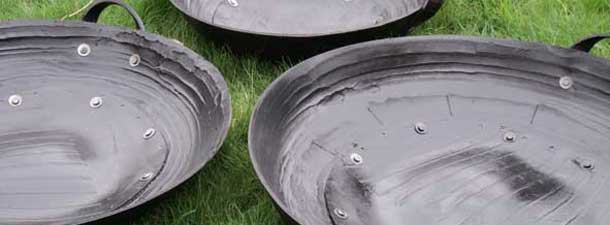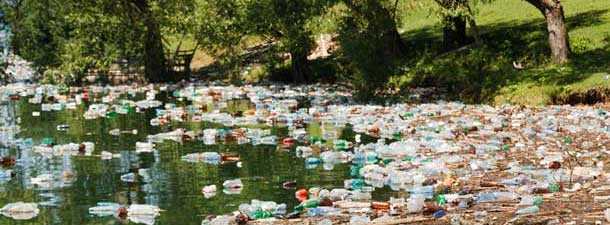
RE-USE ME – The Creative Spirit Of Recycling Design
September 2, 2012
American Apocalypse – Then and Now
September 2, 2012Both our environment and our own bodies seem ever more under siege from chemicals, plastics, pollution, climate change – the list is extensive. Most of us would do something if we could – to help the planet, to protect ourselves – but often feel overwhelmed and even helpless in the face of this deluge. No one of us can solve the problem through our individual efforts alone, but it can be solved if we all contribute. A good place to start is with our own choices in just a couple of areas: our use of plastics, and our choice to eat sustainably and organically grown food where possible and thereby encourage pioneers of holistic agriculture, such as the biodynamic farmers.
O
Our lives are infinitely easier than they were thousands, hundreds, even fifty years ago. In many places we have unlimited, 24-hour access to information, communications, goods, news, anything we need or could possibly want through the internet. We buy disposable items, throw them out and get new ones. We have the ability to buy seasonal food throughout the year, from all over the world. In the past this was unavailable to us. This food is grown utilising chemicals and pesticides, flown, shipped, or driven thousands of miles to reach our doorstep or that of our local market. The food often arrives in plastic containers or with plastic covering to protect it. We then put in it plastic bags, along with other products when we purchase it (globally over 500 billion bags a year). We drink out of plastic cups and eat off plastic plates when we are out of, and sometimes even when in, our homes. All over the planet these plastics wind up in landfills, incinerated in garbage dumps (spewing toxic chemicals into the air) and littering the waterways and roadways causing death and destruction.

Large-scale industrial farmers have, in most cases, raped the soil. They mistreat it, ignoring the needs of the earth to produce large and continuous amounts of produce, often at the expense of nutrition and taste. This requires ever-increasing amounts of chemicals, pesticides and inorganic fertilisers – all of which we know contributes to disease in ourselves and the other beings with whom we share this earth. In my opinion, bigger is not better and the best genetic engineer is Nature.
But Mother Nature is being worn down, overloaded with “input” – as are many humans. As a species, the state of our long-term health, the increase in our chronic diseases, is mirroring that of our quintessential Mother – our Mother, who provides our basic needs: air, water, food, shelter and so much more. As we pollute our land and waterways and mismanage our environment, we ultimately see the results reflected in ourselves and the innocent species around us. We have the ability to change this, the ability to decrease our contact with toxic chemicals in our daily life.
I am in no way suggesting that the conveniences that we have should be renounced; just, perhaps, that we should use a little bit more discretion, common sense and responsibility. Everyone, individuals and corporations alike, should try to take just a few moments everyday to make better choices; to make the effort, when we buy or produce food, drinks, and products, to be aware and conscious of our choices and actions. We must acknowledge the effects that our choices have on our well-being, our environment and the long-term health of the planet.
There are many ways we can accomplish this. Two things we can start with are decreasing our plastics use and choosing foods that have been grown using, at minimum, organic standards if not biodynamic standards.

Plastic
Plastic has revolutionised the world we live in. It is found in our cars, computers, phones, planes, trains, cars, office buildings, homes, grocery stores, food containers, children’s toys – the list is endless! Plastic items are inexpensive, accessible, and portable. Plastic can be moulded into many different shapes, densities, and objects. What makes it so useful is also what makes it so destructive.
Globally, 300 million tons of plastic is produced each year, only ten percent of it being recycled. We know that certain plastics – their use, misuse and disposal – are poisoning and strangling our world. We know that chemicals in our foods are causing many diseases.
 |
 |
Some plastics are great when used correctly and responsibly. The issue with plastic is that it is here for the duration. It is not going any where. It will be around for thousands of years, quite literally. Recently, there has been more research available and more global noise heard around the use and misuse of plastic, its production and its destruction. We treat it as a disposable product instead of as a re-useable product. Some of its uses cannot be changed, but for others we can greatly reduce, reuse (when safe), and eliminates. In doing so, we decrease the stress on the earth and ourselves.
 |
 |
Plastic originated in the 1800s from bio-derived materials such as egg, milk proteins, animal horn, lye and rubber. In 1870, John Hyatt invented celluloid. Next, Leo Baekeland discovered phenols and formaldehyde which, when heated, solidified into hard plastic, the iconic “Bakelite” in homage to its inventor. In 1930, nylon was created – stockings for all! In 1951, modern plastic was born with the discovery of polyethylene and polypropylene. And from then on, “They’re off!” , as they say at the races. The production of plastic grows by nine percent a year. Most kinds are made from crude oil and natural gas. There are growing numbers of plastics that are derived from corn, sugar cane or algae.
 |
 |
In general, crude oil is refined to break down its components into usable building blocks for the manufacture of plastics, fertilisers, pesticides, asphalt and fuels such as petrol, diesel, jet fuel and motor oil. There are a number of steps to refine the oil for making plastic but eventually it is reduced to a white powder known as “fluff”. This is then combined with additives and fillers, depending on the type of plastic to be manufactured. The mixture is turned into pellets called “nurdels” and shipped to a manufacturer to be moulded into the desired end product.
There has been an increase in the use of biodegradable plastics made from corn, algae and other materials. Although this might be a better choice, these will still take a long, long time to break down in our landfills and should be used with care and responsibility. Biodegradables may be useful in disposable packaging that can’t be separated from organic wastes, such as required by catering or in the agricultural sector.
The plastic product you choose can affect your health and your environment. Chemicals that are added to them to give them shape can be absorbed by the human body, resulting in altered hormonal states and other harmful conditions. Plastic material in landfills leeches harmful chemicals into groundwater. Plastic debris can survive for thousands of years in water. We are repeatedly exposed to chemicals through plastic in air, dust, water, food and use of consumer products.
Studies have found the plastics we use for food storage, baby toys, dummies (pacifiers) and water bottles may contain something called Bisphenol A, or BPA. BPA is a synthetic chemical that interferes with the hormonal system of the body. The US Center for Disease Control and Prevention (CDC) found detectable urine levels of BPA in 93% of people tested. The chemical has been linked to obesity, breast cancer, heart disease, diabetes, birth defects and reproductive disorders (see chart). BPA can also wreak havoc on the developing systems of children’s bodies. It is released from plastics that are labelled “microwaveable” when they are heated. [1]
Polybrominated diphenyl ethers (PBDEs) are found in flame retardant materials, added to furniture cushions, mattresses, carpets and automobiles. They have been linked to brain disorders, and reproductive health issues.
Chemicals that might cause little or no threat to adults can have a severe impact on the long-term health of infants and young children. Exposure to small amounts of certain chemicals commonly found in such plastic items like food and beverage containers, cosmetics and flame retardant materials can lead to the development of prostate cancer, diabetes, obesity, infertility and attention deficit disorder. It was always thought that the “dose makes the poison”, but now attention is being paid to the timing of the dose. Interactions with these chemicals at a young age may “turn on or turn off” the gene expression for many chronic diseases.
Water bottles that are label 1 (PET, PETE) should not be reused. These types of bottles may leach DHEP (a suspected human carcinogen) into the water. When they are used repeatedly they begin to degrade. Bacteria can get caught on the inside of the plastics resulting in contamination. After prolonged use, they also may leak antimony, which can cause, at the very least, diarrhea and stomach problems.
PVC (# 3) is toxic. Containers with PVC (#3) can leach carcinogens into the liquids thay are holding. It also produces synthetic carcinogens when incinerated, such as dioxins, which pollute our air and water. Not only do we inhale and digest this from these sources but it seeps into our food chain as well, increasing contamination and exposure. Dioxins bind to fat and accumulate in the body especially in women’s breast milk. Dioxins have been linked to many diseases, including breast, skin, liver, stomach, and brain cancer, and Hodgkins lymphoma. It can also act as a hormone in the body, disrupting the normal patterns, affecting reproductive systems and increasing developmental delay.

| Type of Plastic | Number | Common Uses | Adverse Health Concerns | Good /Bad Choice |
|---|---|---|---|---|
| PolyethyleneTerephthalate(PET or PETE) | 1 | soft drink bottles,peanut butter, ketchup,jars, drinking glasses,
plastic bags, toys, food containers |
Polyethelene is a suspectedhuman carcinogen.Not known to leach any
chemicals that can disrupt hormones or cause cancer when used correctly. |
Good when used as directedOne time use best23% Recycle Rate
Easiest plastic to recycle Not resistant to high temperatures so washing in them for re-use can start to degrade plastic and cause it to harbour bacteria |
| High DensityPolyethyleneHDPE | 2 | milk, juice, waterjugs, laundry, dishdetergent, shampoo,
grocery bags (often opaque) |
Appears to be safe. | GoodCan be recycled into more bottles orbags
27 % recycle rate |
| PolyvinylchloridePVC | 3 | meat wraps, cookingoil bottles,baby bottle teats,
shrink wrap, coffee containers, garden hose, blood bags |
Can cause cancer, birth defects,genetic changes, chronicbronchitis, ulcers, skin disease,
vision defects. |
BADDifficult to recycle |
| Low DensityPolyethylene | 4 | heavy duty bags, breadbags, squeezable bottleplastics, plastic food
wrap |
Appears to be safe. | GoodLess than 1% recycledCan be put through dishwasher. |
| PolypropylenePP | 5 | medicine bottles,cereal liners, packingtape, straws | Appears to be safe. | Good3% recycle rateHazard in production. |
| Polystyrene | 6 | Take-away foodcontainers, disposablecutlery, cups, meat
trays, packing peanuts, CD and Video Cases |
– | BadAvoid. May leach styrene, a possiblehuman carcinogen. |
| PolycarbonatePC | 7 | baby bottles, watercoolers, water bottles,car parts | Low doses of BPA (BisphenolA) have been linked to cancer,impaired immune function,
early-onset puberty, obesity, diabetes, hyperactivity. BPA dangerous during fetal development. |
Caution:Concerns with leaching Bisphenol Awhich can cause chromosomal damage.
Not all #7 contains BPA Less than 1 % recycled |
| Polyester | 8 | bedding, clothing,disposable nappies,food packaging,
upholstery |
Can cause eye irritation,respiratory tract irritation andacute skin rashes. | |
| Acrylic | 9 | clothing, blankets,carpets, adhesive,contact lenses,
floor waxes, food preparation equipment |
Can cause breathing difficulty,vomiting, diarrhea, nausea,weakness, headache and
fatigue. |

Recycle
Millions of bottles end up in landfills, being incinerated, or creating toxic ecosystems in our oceans. Eighty-six percent of ocean debris is plastic. Microscopic pieces of plastic have worked their way down into plankton in the deep ocean, to the very bottom of the food chain. Nine percent of fish sampled have plastic in their stomachs. Dolphins, seals, whales, albatrosses, pelicans – to name just a few – can eat pieces of plastic sheeting or bottle caps which they mistake for prey. They also get entangled in discarded fishing nets. Studies on birds called fulmars by Save the North Sea Project found 95% had plastic debris in their stomachs, an average of 40 pieces per bird. Over a million seabirds and marine mammals die each year from plastic ingestion and entanglement. [4]

Worldwide the amount of plastic litter ruining the roadways and waterways is apparent. Some countries have started to do something about it. China has stopped stores from providing free plastic bags. Mumbai, Australia, Ireland, Italy, Tanzania, South Africa, Bangladesh, Kenya, Taiwan, and various US cities have banned plastic bags or created fines or taxes on their use. Retail stores and supermarkets are taking money off the total bill if you bring your own bags or are providing cloth bags of their own for re-use. Designers are creating cloth bags out of recycled materials and either selling for charitable purposes or placing your purchases in them. Companies are using less plastic to ship or package their products. Beverage companies are decreasing the amount and type used in bottles. The Plastics Disclosure project has encouraged companies to join and assess their plastic footprint. The first step in making change is to know what you are consuming!

Rules to live by:
[arrowlist]
- Avoid plastics with symbol #3 – PVC Polyvinyl Chloride, #6 Polystyrene or Styrofoam, & #7 – polycarbonate and a wide variety of other plastic resins.
- DO NOT microwave food and beverages in plastics EVER.
- DO NOT Microwave or heat plastic cling wraps.
- DO NOT place plastics in the dishwasher.
- DO NOT use water bottles, baby bottles, or children’s cups for hot liquids.
- Use glass or, when you must, symbol #1 or # 2 plastics. Follow directions for plastic and RECYCLE. Don’t leave plastic littering the street, the beach, the landfill or the incinerator. When these plastics degrade or burn they release toxic chemicals into our water, food, air and lungs!
- Look for BPA-free labels
- You can reuse #4 plastic food bags when you wash them in warm soap and water. (When any plastic product becomes cloudy it means it has begun to degrade.)
- Take cloth bags with you when you shop for groceries, clothes – or any type of shopping, really. It greatly reduces the number of plastic bags that line our waterways, roads, and lakes.
- If you must use plastic grocery bags re-use them for carrying other products a few times before recycling.
- Buy items that have reduced packaging.
- YOU ARE RESPONSIBLE.
[/arrowlist]
Biodynamic Farming
Dr. Rudolph Steiner developed biodynamic farming in the 1920s. It is a closed system where everything that is used on the farm or the vineyard comes from that particular piece of earth. Everything is important: the plants, the animals, the compost. The grower, the growing, the livestock, and the earth are all interconnected. Today there are thousands of successful farms, vineyards and agriculture operations in various countries that participate in this type of farming. These farms create healthy and balanced ecosystems by working within nature and by having a closed internal system. They use plants and animals and their by-products, from within the farm itself, to produce healthy soil and stronger plants. The biodynamic farmer is in tune with their piece of the earth. They know and understand the cycles and interrelationship of the earth, the moon and the planets, and how they affect the growth of plants. The farmers time their activity with an eye to the best advantage of the crops they are growing. For example, when is a good time to germinate, plant, water? When is insect activity or fungus growth at its highest? Which compost should be used and when?
Biodynamic farmers learn to read the musical notes of nature by observing the wet and dry areas, how things look in full sun or shade, the state of the soil, the sound of the birds and insects. They compose a symphony out of these observations that nourish the soil and therefore promote vitality in the crops they bring into life.
| Compost Herb Teas | Uses |
|---|---|
| Yarrow | [arrowlist]
[/arrowlist] |
| Camomile | [arrowlist]
[/arrowlist] |
| Stinging nettle | [arrowlist]
[/arrowlist] |
| Valerian | [arrowlist]
[/arrowlist] |
| Oak Bark | [arrowlist]
[/arrowlist] |
| Horsetail | [arrowlist]
[/arrowlist] |
| Dandelion | [arrowlist]
[/arrowlist] |
Benziger Vineyards, a family-owned, -farmed and -managed business located in Glen Ellen, Sonoma County, California, grows its grapes using biodynamic standards. It wasn’t always that way. The Benziger family – parents Bruno and Helen, and offspring Mike, Chris, Bob, Joe, Erin, and Kathy – migrated from New York in the 1980s and farmed the land using standard growing techniques: non-organic fertilisers, pesticides, etc. It worked well enough, but eventually Mike Benziger noticed the farm was really quiet – not as many birds, not as many insects; the soil looked different, the plants drier. In the 1990s he met Alan York an international expert on biodynamic farming, and they began the transition to a biodynamic vineyard. They planted cover crops, olive trees, plants that attracted beneficial insects and created habitats and wetlands for birds, bees and other animals. They bought sheep, cows and chickens. They now rely on composting made of the cover crops and manure from the cows for fertiliser; the natural predator/ prey relationships for insecticide. They grow the needed herbs for the biodynamic teas that are used throughout the growing season.

Benziger Family Winery
Winegrowing and Biodynamics Farming
Biodynamic principles use what are preparations, or preps – as aids to fertilisation. Two preps – horn manure and horn silica, are used directly in soil preparation (the others are used in composting). Horn manure is aged into humus and then sprayed onto the earth for fertiliser at the appropriate time. Horn silica is used to enhance photosynthesis. Fine quartz crystals are put into cow horns and aged in the earth then sprayed on the leaves of the plants. Again, compost is also a major component of a biodynamic farm. They grow yarrow, camomile, stinging nettle, valerian, oak bark, horsetail, and dandelion. Each of these, when added to the compost mixture, has a specific metabolic function that provides the plants and soil with the nutrients they need. Jessica La Bounty of Benziger vineyards explained that although initially this might seem like more work, in the long run there is less disease, better growth and a better product. They use the different tea composts at different times of the year for different purposes. Jessica shared that the “owners have a close connection to the land.” For example, if they know an area tends to be wet they will continually check it, then create a tea of horsetail, which is drying, to reduce the risk of moulds.
Everything on the farm goes back into the compost – the cuttings, the stems, the cover crop, the manure. The farmers plant different crops on a rolling basis in different areas between the vines. They also have vegetable gardens. These crops enhance predator/prey relationships by creating natural habitats. The animals do their part too. The vineyard has sheep that play an important role in removal of overgrown cover crop while providing nutrient rich fertiliser for the soil. As an added bonus, the presence of sheep eliminate the need for mowing and herbicides. The cattle also provide grazing and building blocks for compost, as well as endowing the vineyard with a sense of tranquility.
This is just one example of biodynamic farms and how they are striving to heal the earth while producing healthy, vital, growing plants. The Benziger vineyard achieved Demeter Certification (from Demeter International, the Biodynamic certifying body) in 2000 and has continued to earn the certification annually since that time. The Demeter Certification is a not-for-profit global certification that must be awarded annually to a farm, which ensures they follow biodynamic standards. Benziger Vineyard is also carbon neutral and uses recycled water to decrease water consumption on the vineyard. The Benzigers also started a sustainable farming and organic farming cooperative in their area.
Who in their right mind would choose food, plants or animals, that were commercially farmed when you could choose foods that have been grown with care, fed right, whose soil was healthy, whose grains or grasses were grown in that healthy soil? Plants or animals, including people, are happier when nurtured. The cells in your body work better when given the nutrients that they need. When you eat or drink products made with produce from healthy soil, that don’t use chemicals, that aren’t wrapped in plastics – well, then your body, your immune system, can work with less effort, better and smarter.
A final thought then: a few simple steps, a few educated choices – heal the world, heal yourself!
[note]
[1] National Toxicology Program, National Institute of Environmental Health Sciences NIH-HHS, United States. “Bisphenol A Fact Sheet”; www.niehs.nih.gov/health/assets/docs_a_e/bisphenol-a-factsheet.pdf, retrieved July 17, 2012.
[2] Local Authorities International Environmental Organisation (KIMO), Sweden-Northern Europe. “KIMO is collaborating with Plymouth University to reveal the ecological impact of microscopic plastics.” www.fishingforlitter.org/microplasticresearch.aspx; retrieved July 17, 2012.
[3] State of New Jersey Department of Human Services, Office for Prevention of Developmental Disabilities, New Jersey, USA. “BPA – Bisphenol A – possible effects during fetal development or on newborns.” www.nj.gov/humanservices/opmrdd/health/bpa.html; retrieved July 17, 2012.
[4] www.fishingforlitter.org/microplasticresearch.aspx; retrieved August 5, 2012.
[/note]







